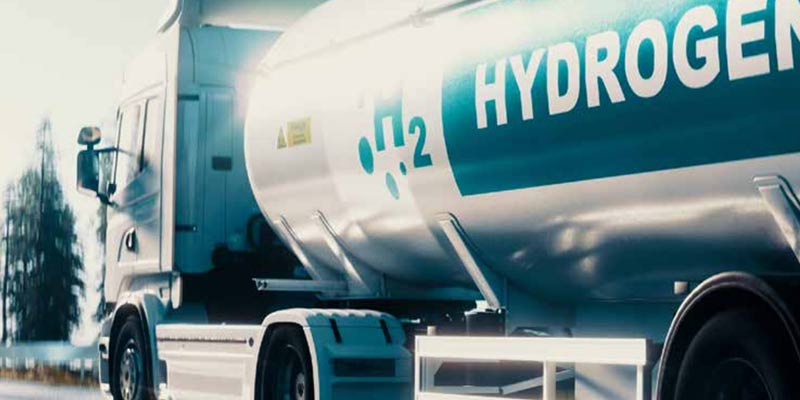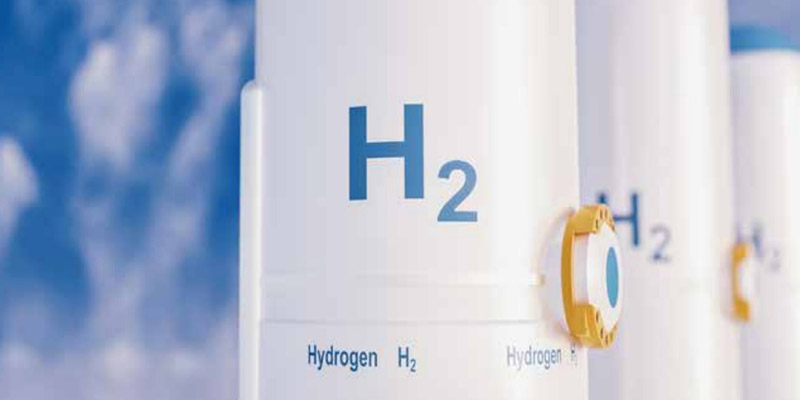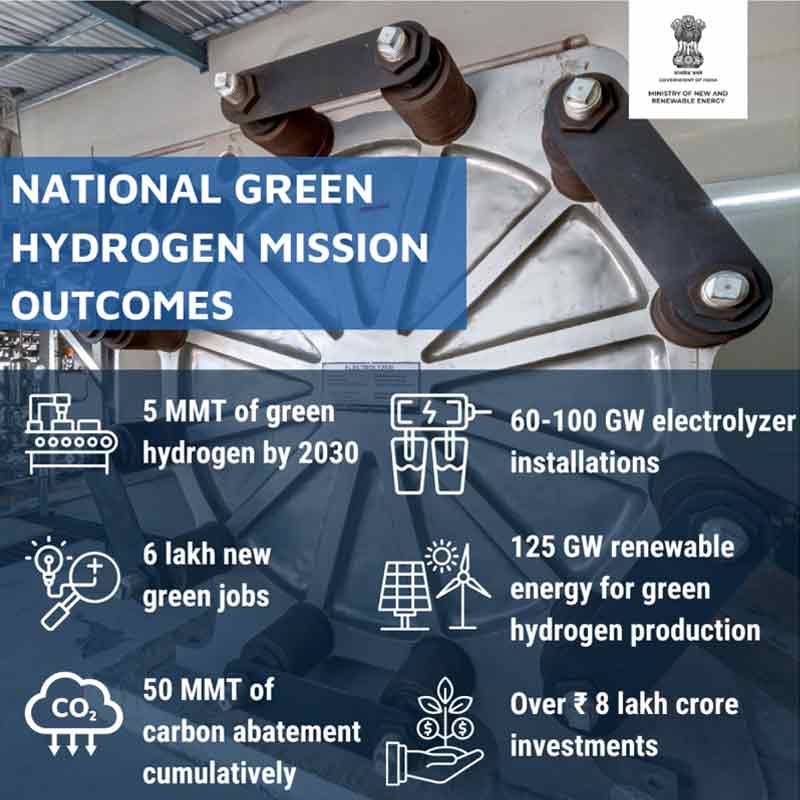- India
- May 29
Explainer - Hydrogen fuel cell
• The Indian Army has collaborated with the Indian Oil Corporation Limited (IOCL) for incorporating green and sustainable transport solutions in the force.
• This initiative aims to promote hydrogen and fuel cell technology for heavy-duty e-mobility, positioning the Indian Army as a pioneer in evaluating this technology.
• One hydrogen fuel cell bus was received by the Indian Army under the framework of the collaboration.
• The hydrogen fuel cell bus has a seating capacity of 37 passengers. It promises an impressive mileage of 250-300 km on a full 30 kg tank of hydrogen fuel.
What is a fuel cell?
• A fuel cell uses the chemical energy of hydrogen or other fuels to cleanly and efficiently produce electricity.
• If hydrogen is the fuel, the only products are electricity, water, and heat. Fuel cells are unique in terms of the variety of their potential applications
• Fuel cells have several benefits over conventional combustion-based technologies currently used in many power plants and vehicles.
• Fuel cells can operate at higher efficiencies than combustion engines and can convert the chemical energy in the fuel directly to electrical energy.
How fuel cells work?
• Fuel cells work like batteries, but they do not run down or need recharging.
• They produce electricity and heat as long as fuel is supplied.
• A fuel cell consists of anode (a negative electrode) and cathode (a positive electrode) sandwiched around an electrolyte.
• A fuel, such as hydrogen, is fed to the anode, and air is fed to the cathode.
• In a hydrogen fuel cell, a catalyst at the anode separates hydrogen molecules into protons and electrons, which take different paths to the cathode.
• The electrons go through an external circuit, creating a flow of electricity.
• The protons migrate through the electrolyte to the cathode, where they unite with oxygen and the electrons to produce water and heat.
Advantages of hydrogen fuel cell:
• The fuel cell utilises hydrogen and air to generate electricity to power the bus, whose only effluent is water, thereby making it possibly the most environment-friendly mode of transportation.
• For comparison, a single diesel bus plying on long distance routes typically emits 100 tonnes of CO2 annually and there are over a million such buses in India.
• The high efficiency of fuel cell vehicles and the high energy density of hydrogen ensures that the operational costs in rupees per kilometre for fuel cell trucks and buses are lower than diesel powered vehicles and this can bring freight revolution in India.
• Moreover, fuel cell vehicles also give zero greenhouse gas emissions.
• About 12-14 per cent of CO2 emissions come from diesel powered heavy vehicles. Hydrogen fuel cell vehicles provide excellent means to eliminate on-road emissions in this sector.
The need for transition to hydrogen
• Rise of technologies such as solar and wind, lithium-ion batteries, and alternative fuels have paved the way for decarbonisation in various end-use sectors.
• However, there are certain sectors like industry and heavy transport that are hard to decarbonize using the current low or zero-carbon technologies. Hydrogen promises to address those challenges and contribute to the decarbonisation of these hard-to-abate sectors.
• Hydrogen is an energy carrier and can be used for a wide array of energy and industrial applications. The opportunities and challenges of hydrogen emerge from its energy characteristics.
• Hydrogen’s specific energy (energy content per unit of mass) is higher than most hydrocarbon fuels. But its volumetric energy density is the lowest. That means pressurisation or liquefaction is required for hydrogen to be useful as a fuel. These two properties drive the value as well as the applicability of hydrogen for the various possible end-use cases.
• Many sectors such as iron ore and steel, fertilisers, refining, methanol, and maritime shipping emit major amounts of CO2, and carbon-free hydrogen will play a critical role in enabling deep decarbonization.
• For other high-emitting sectors, such as heavy-duty trucking and aviation, hydrogen is among the main options being explored with an outlook to be the preferred solution for several applications.
• This has resulted in growing global momentum towards hydrogen in general, and green hydrogen in particular.
• There is an increased consensus around the world that concerted steps need to be taken to reduce global warming to levels less than 2°C and if possible to cap it at 1.5°C higher than pre-industrial levels. Various countries have pledged their Nationally Determined Contributions to ensure energy transition and reduce emissions.
• Declining prices of hydrogen, coupled with growing urgency for decarbonization means the global demand for hydrogen could grow by almost 400 per cent by 2050, led by industry and transportation.
• A NITI Aayog report has estimated that the cumulative value of the green hydrogen market in India will be $8 billion by 2030 and $340 billion by 2050.
What is green hydrogen?
• Although hydrogen is the lightest and most abundant element in the universe, it is rarely found in nature in its elemental form and always must be extracted from other hydrogen-containing compounds. It also means that how well hydrogen contributes to decarbonisation depends on how clean and green the method of production is.
Based on the sources and processes, hydrogen can be classified into various colours:
i) Black/Brown/Grey hydrogen is produced by coal or lignite gasification (black or brown), or via a process called steam methane reformation (SMR) of natural gas or methane (grey). These tend to be mostly carbon-intensive processes.
ii) Blue hydrogen is produced by natural gas or coal gasification combined with carbon capture storage (CCS) or carbon capture use (CCU) technologies to reduce carbon emissions.
iii) Green hydrogen is produced using electrolysis of water with electricity generated by renewable energy. The carbon intensity ultimately depends on the carbon neutrality of the source of electricity. Which means, the more renewable energy there is in the electricity fuel mix, the “greener” the hydrogen produced.
National Green Hydrogen Mission
In January 2023, Prime Minister Narendra Modi-led Cabinet approved the National Green Hydrogen Mission with an outlay of Rs 19,744 crore.
The Mission is expected to attract Rs 8 lakh crore of investment in the green hydrogen chain.
India aims to produce 5 million tonnes of green hydrogen per annum in five years and the incentives would help bring down the cost.
Significance of this Mission
• India has a unique opportunity to become a global leader in the hydrogen energy ecosystem. With proper policy support, industry action, market generation and acceptance, and increased investor interest, India can position itself as a low-cost, zero-carbon manufacturing hub, at the same time fulfilling its goal of economic development, job creation, and improved public health.
• The current impetus surrounding the hydrogen transition fits well within the context of a low-carbon economy, energy security, and the larger economic development ambition of the nation.
• Hydrogen demand in India could grow more than four-fold by 2050, representing almost 10 per cent of global hydrogen demand. Initial demand growth is expected from mature markets like refinery, ammonia, and methanol, which are already using hydrogen as industrial feedstock and in chemical processes.
The Mission will have wide ranging benefits:
i) Creation of export opportunities for green hydrogen and its derivatives.
ii) Decarbonisation of industrial, mobility and energy sectors.
iii) Reduction in dependence on imported fossil fuels and feedstock.
iv) Development of indigenous manufacturing capabilities.
v) Creation of employment opportunities.
vi) Development of cutting-edge technologies.
• The Mission will facilitate demand creation, production, utilisation and export of green hydrogen.
• Under the Strategic Interventions for Green Hydrogen Transition Programme (SIGHT), two distinct financial incentive mechanisms — targeting domestic manufacturing of electrolysers and production of green hydrogen — will be provided under the Mission.
• The Mission will also support pilot projects in emerging end-use sectors and production pathways.
• Regions capable of supporting large scale production and/or utilisation of hydrogen will be identified and developed as Green Hydrogen Hubs.
• An enabling policy framework will be developed to support establishment of the green hydrogen ecosystem. A robust standards and regulations framework will be also developed.
• A public-private partnership framework for R&D (Strategic Hydrogen Innovation Partnership — SHIP) will be facilitated under the Mission.
• R&D projects will be goal-oriented, time bound, and suitably scaled up to develop globally competitive technologies. A coordinated skill development programme will also be undertaken.
• All concerned ministries, departments, agencies and institutions of the central and state governments will undertake focussed and coordinated steps to ensure successful achievement of the Mission objectives.
Manorama Yearbook app is now available on Google Play Store and iOS App Store




